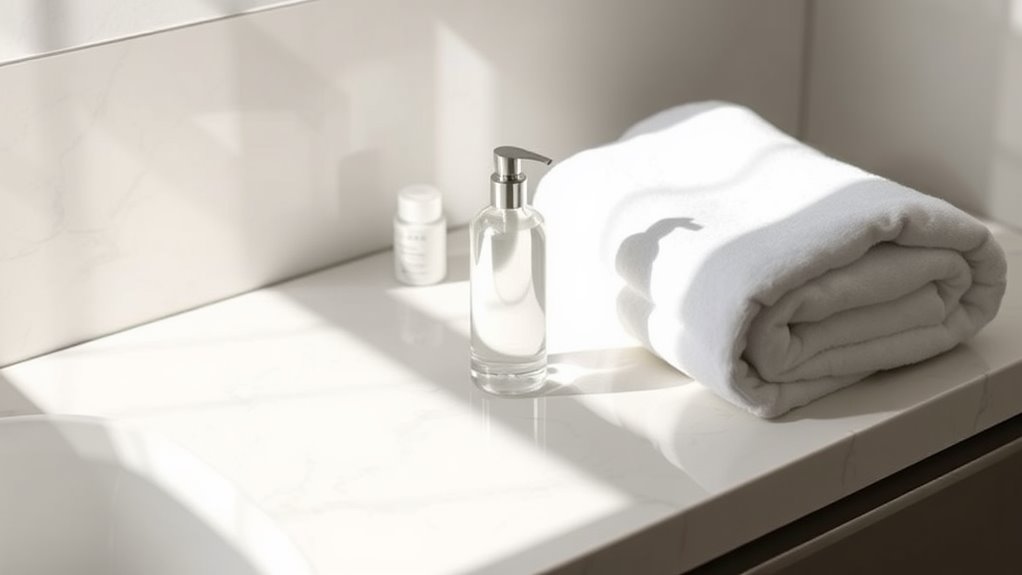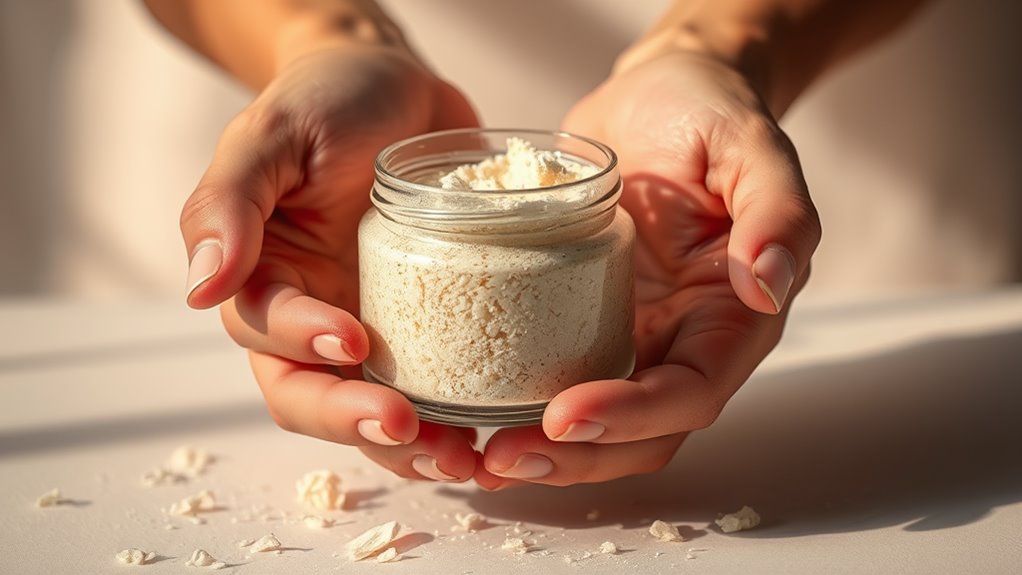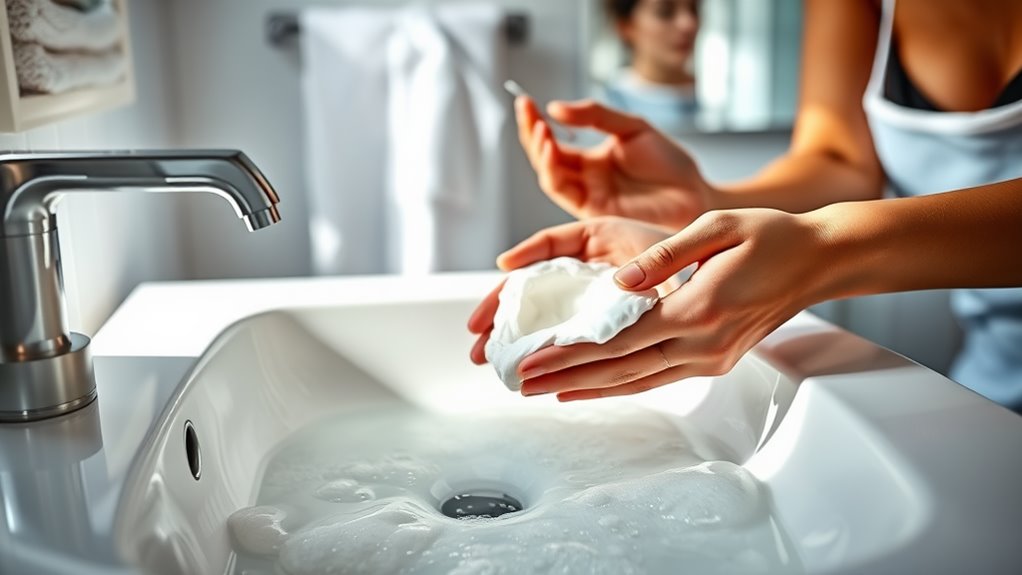What Happens When You Over-Exfoliate – And How to Reverse It
Over-exfoliating your skin can lead to increased sensitivity, redness, and dryness by disrupting your skin barrier. You may experience irritation, stinging, or breakouts from damaged skin struggling to recover. To reverse the effects, focus on soothing your skin with gentle cleansers and hydrating serums, and apply a nourishing moisturizer. It’s essential to adjust your exfoliation frequency based on your skin type. Discovering the best practices for a balanced routine can help you achieve healthier skin.
Key Takeaways
- Over-exfoliation leads to increased skin sensitivity, redness, and inflammation, compromising the skin barrier.
- It can cause persistent dryness, flakiness, and breakouts due to excess oil production.
- To reverse damage, switch to gentle cleansing and hydrate with mild, fragrance-free products.
- Incorporate soothing ingredients like hyaluronic acid and aloe vera to aid recovery.
- Always apply broad-spectrum sunscreen daily, as exfoliated skin is more vulnerable to UV damage.
Understanding Exfoliation: The Basics
Exfoliation is a fundamental skincare process that removes dead skin cells from the surface of your skin, promoting a smoother texture and a brighter appearance. Understanding this process is crucial for achieving optimal skin health.
You can choose between physical exfoliation, which involves scrubs or brushes, and chemical exfoliation, utilizing acids to dissolve dead skin. Regular exfoliation enhances cell turnover, but moderation is key. Over-exfoliation can lead to skin barrier damage, resulting in irritation and sensitivity. The dangers of over-exfoliating your skin can include increased redness and peeling.
In the context of over exfoliation recovery, give your skin a break and focus on hydrating and soothing products. Incorporate gentle ingredients like ceramides and hyaluronic acid to restore balance.
Mastering this balance will enhance your skincare routine and support long-term skin health.
Signs of Over-Exfoliation
When you over-exfoliate, your skin may exhibit several distressing signs that indicate it’s time to reassess your routine.
You might notice increased sensitivity, where even gentle products cause discomfort. Redness and inflammation can surface, signaling irritation and a compromised barrier.
Persistent dryness or flakiness may occur as your skin struggles to retain moisture. Additionally, you could experience breakouts, as damaged skin may overreact by producing excess oil.
Uneven texture and dullness are also common, as over-exfoliation can hinder natural skin renewal processes. The effects of over-exfoliation can be detrimental to your skin’s overall health and resilience.
If you recognize these signs, it’s crucial to reduce your exfoliation frequency and incorporate soothing ingredients to restore balance and health to your skin.
Prioritize recovery to prevent long-term damage.
Immediate Effects on Your Skin
Over-exfoliation can lead to immediate and noticeable effects on your skin. You may experience heightened redness and irritation, as the protective barrier weakens, leaving your skin vulnerable. Sensitivity increases, often resulting in a stinging or burning sensation upon applying products. Additionally, you might notice increased dryness and flakiness, as over-exfoliation disrupts natural moisture retention. This imbalance can also trigger excessive oil production, leading to breakouts and congestion. You may observe a dull complexion, as the skin struggles to recover from the trauma. These immediate effects serve as critical signals that your skin requires urgent attention and care. Recognizing these signs is the first step toward restoring your skin’s health and equilibrium. Furthermore, harsh exfoliation can cause long-term damage, making it essential to address these symptoms promptly.
Long-Term Consequences of Over-Exfoliation
If you ignore the signs of over-exfoliation, you might face long-term consequences that can significantly impact your skin’s health. Extended periods of aggressive exfoliation can lead to compromised skin barriers, increased sensitivity, and heightened risk of hyperpigmentation. You may also experience premature aging due to a reduction in natural oils and moisture retention. Regular exfoliation is essential to maintain healthy skin texture and prevent these adverse effects.
| Consequence | Description | Long-Term Impact |
|---|---|---|
| Compromised Barrier | Weakened skin barrier due to loss of natural oils | Increased vulnerability to irritants |
| Increased Sensitivity | Heightened reactivity to products and environmental factors | Chronic discomfort |
| Hyperpigmentation | Uneven skin tone from inflammation and irritation | Permanent discoloration |
| Premature Aging | Fine lines and wrinkles appearing sooner | Deteriorated skin texture |
| Acne Flare-Ups | Higher likelihood of breakouts due to irritation | Persistent acne issues |
How to Soothe Irritated Skin
To soothe irritated skin, start with gentle cleansing techniques that minimize further irritation. Incorporating hydrating ingredients, such as hyaluronic acid or aloe vera, can help restore moisture and calm inflammation. Additionally, adopting a gentle cleansing routine is essential in promoting recovery and maintaining skin health.
Gentle Cleansing Techniques
Gentle cleansing techniques are essential for soothing irritated skin, especially after experiencing over-exfoliation. Start by using lukewarm water to avoid further irritation. Choose a mild, fragrance-free cleanser that maintains your skin’s natural barrier. Use your fingertips to apply the cleanser in a circular motion without scrubbing. Rinse thoroughly and pat dry with a soft towel.
| Step | Technique | Notes |
|---|---|---|
| 1 | Use Lukewarm Water | Avoid hot water; it can irritate |
| 2 | Select a Mild Cleanser | Look for fragrance-free options |
| 3 | Apply with Fingertips | Use gentle circular motions |
| 4 | Pat Dry | Avoid rubbing with a towel |
Implementing these techniques will help restore your skin’s balance.
Hydrating Ingredients to Use
When skin becomes irritated due to over-exfoliation, incorporating hydrating ingredients can significantly aid in its recovery.
Look for products containing hyaluronic acid, which attracts moisture and enhances skin hydration. Glycerin is another excellent choice, as it draws water into the skin, promoting a plump appearance.
Aloe vera soothes inflammation and provides a cooling sensation, making it ideal for irritated skin. Additionally, consider ceramides, which help restore the skin barrier, preventing further moisture loss.
Niacinamide can also be beneficial, as it reduces redness and improves the skin’s overall texture. Finally, choose a fragrance-free moisturizer to minimize irritation while ensuring your skin remains adequately hydrated.
Prioritize these ingredients to effectively soothe and restore your skin’s health.
Recommended Products for Recovery
As your skin begins to recover from over-exfoliation, selecting the right products is crucial for restoring its balance and promoting healing.
Opt for gentle cleansers that are sulfate-free and pH-balanced, as these will minimize irritation. Incorporate a soothing moisturizer containing ingredients like ceramides and hyaluronic acid to enhance hydration and barrier function.
Look for serums enriched with niacinamide, which can reduce redness and enhance skin resilience. Avoid products with active ingredients such as retinoids or alpha hydroxy acids during this recovery phase to prevent further irritation.
Instead, consider using a calming facial oil with ingredients like squalane or jojoba oil. Consistency with these products will support your skin’s healing process effectively.
Tips for a Balanced Exfoliation Routine
Finding the right balance in your exfoliation routine is vital for maintaining skin health and preventing over-exfoliation.
Start by assessing your skin type; oily skin may tolerate exfoliation two to three times a week, while dry or sensitive skin should limit it to once a week.
Choose between physical and chemical exfoliants, but avoid using both simultaneously. Always follow exfoliation with a hydrating serum or moisturizer to replenish the skin barrier.
Monitor your skin’s response; if you notice redness or irritation, reduce frequency immediately.
Incorporate exfoliation into a broader skincare regimen that includes sun protection, as exfoliated skin is more susceptible to UV damage.
Consistency and moderation are key to achieving optimal skin health without adverse effects.




